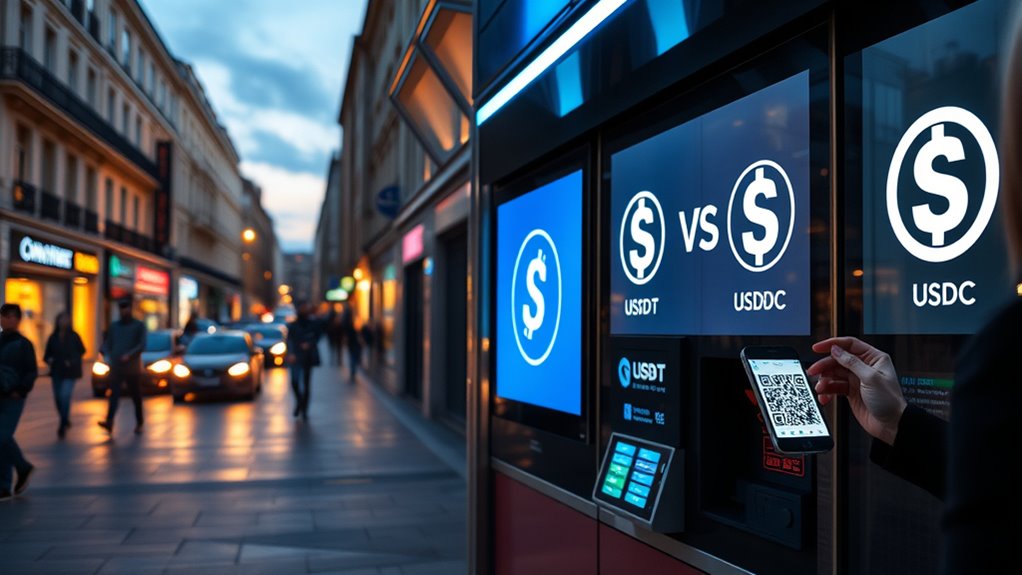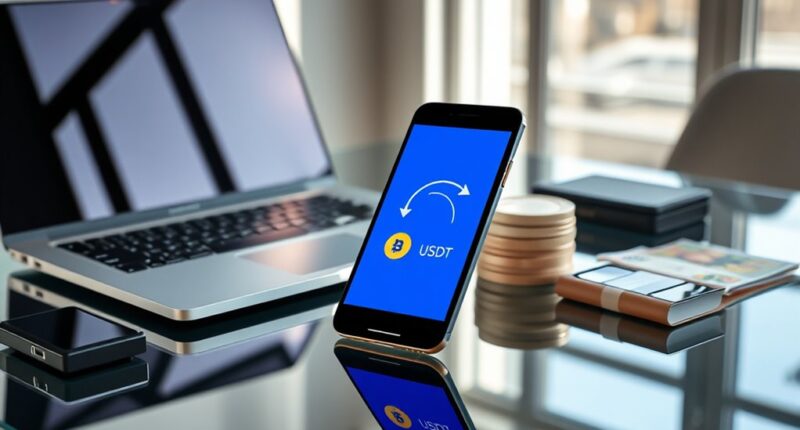To seamlessly exchange USDT for USDC in Europe, start by choosing a supported centralized exchange like Coinbase, Binance, or Kraken, which require completing KYC for security and regulation. Swap your USDT for USDC within their trading platforms on the USDT/USDC pair. If your USDT is on an unsupported network, use bridging services like Layerswap or Hyperlane to transfer funds to a supported chain before swapping. Continuing will reveal more tips to guarantee smooth and compliant conversions.
Key Takeaways
- Use regulated centralized exchanges like Binance, Coinbase, or Kraken to swap USDT for USDC after completing KYC.
- Connect your wallet (MetaMask, WalletConnect) to decentralized protocols such as Uniswap or SushiSwap for direct token swaps.
- Bridge USDT from unsupported networks (e.g., Tron) to supported chains like Ethereum or Polygon before swapping.
- Act before the 2025 MiCA deadline to prevent forced conversions or delistings, ensuring uninterrupted access.
- Transition to USDC aligns with European regulations, offering transparency, compliance, and market stability.

Are you looking to switch from USDT to USDC smoothly? With the evolving regulatory landscape in Europe, this transition is more important than ever. The EU’s MiCA regulation enforces strict transparency and oversight standards on stablecoins, and USDC is fully compliant, making it a preferred choice for users. USDT, on the other hand, falls short of these requirements due to its lack of transparency and regulatory oversight. As a result, many European exchanges are delisting USDT or restricting its trading pairs to adhere to MiCA rules. This shift means you’ll need to convert your USDT holdings to USDC to stay compliant and guarantee uninterrupted trading and payments.
Switch USDT to USDC to stay compliant with Europe’s MiCA regulations and ensure uninterrupted trading.
To make the swap, the most straightforward method is through centralized exchanges like Binance, Coinbase, or Kraken, which support USDT to USDC conversions and have a significant user base in Europe. These platforms typically require you to complete KYC procedures, which enhance security and regulatory compliance. Once verified, you can place a swap order directly on the platform, selecting the USDT/USDC trading pair. These exchanges handle the conversion seamlessly, providing a secure and efficient process. Alternatively, decentralized exchanges such as Uniswap, PancakeSwap, or SushiSwap also support direct USDT/USDC swaps on supported chains like Ethereum or Polygon. To use these, you’ll need a compatible wallet, such as MetaMask, WalletConnect, or Phantom, which connects to the DEX. Simply select the USDT/USDC pair, confirm the network (Ethereum, Polygon, etc.), and execute the swap. It’s essential to verify that you’ve selected the correct network to avoid any issues with your assets.
If your USDT resides on unsupported networks like Tron, you’ll need to bridge your tokens to a supported blockchain first. Services such as Hyperlane, Layerswap, or Meson facilitate this process. Connect your wallet for the origin network (e.g., TronLink for Tron) and the destination (e.g., MetaMask for Ethereum). Specify the source and target chains, then initiate the bridge. Once your USDT arrives on a MiCA-supported chain, you can swap it for USDC on a DEX. This step guarantees your assets become compliant and usable in regulated payment and trading flows. Timing is critical—MiCA regulations are fully enforced throughout 2025, with specific platform deadlines, such as Coinbase’s plan to delist USDT by December 2025. Missing these deadlines could lead to forced conversions or frozen assets, so acting promptly guarantees uninterrupted access. Furthermore, the European regulatory environment is becoming increasingly strict, and staying ahead of these changes ensures your assets remain protected and accessible. A higher contrast ratio can also enhance the clarity and detail of visual content, making financial dashboards and charts easier to interpret during trading sessions.
The market landscape is shifting quickly. USDT remains the largest stablecoin globally but is losing ground in Europe, where USDC’s transparency and compliance are attracting more users. The adoption of euro-backed stablecoins like EURC and EURS also supports this transition. By converting your USDT to USDC now, you align with regulatory standards, avoid potential disruptions, and participate in Europe’s growing compliant stablecoin ecosystem. This proactive approach guarantees your assets remain accessible, compliant, and ready for the evolving European crypto environment.
Frequently Asked Questions
Are There Any Tax Implications When Exchanging USDT for USDC in Europe?
When you exchange USDT for USDC in Europe, there might be tax implications if you realize a gain from the exchange. If the value of USDT has increased since your acquisition, you could owe capital gains tax, depending on your country’s rules. In Austria, this gain is taxed upon disposal, while in Germany and the UK, specific holding periods and thresholds apply. Always keep detailed records of your transactions.
What Are the Best Times to Exchange USDT for USDC?
You should exchange USDT for USDC during European and US market session overlaps, typically between 1 pm and 4 pm GMT, when liquidity peaks and spreads are tighter. Avoid trading outside these hours, as lower volume increases costs. Keep an eye on major exchange platforms, as they often offer better rates during peak times. Also, consider EU regulatory updates that might influence liquidity and timing for smoother trades.
Can I Exchange USDT for USDC Without Using a Centralized Exchange?
Yes, you can exchange USDT for USDC without a centralized exchange. You can use decentralized exchanges like Uniswap, SushiSwap, or PancakeSwap, which facilitate peer-to-peer swaps directly from your wallet. Make sure you’re on the right blockchain network, such as Ethereum or Tron, and be aware of gas fees. Alternatively, peer-to-peer platforms and stablecoin ATMs also let you swap USDT for USDC without involving centralized entities.
Are There Any Fees Specific to European Exchanges for USDT-USDC Swaps?
European exchanges often charge specific fees for USDT-USDC swaps, including trading fees, withdrawal fees, and network transaction costs. For example, Binance may waive these fees during promotional periods, but Kraken and Coinbase might still impose charges depending on your trading volume or transaction size. Additionally, network fees vary based on the blockchain used, with Tron typically offering the lowest costs. Always check platform details to minimize your expenses.
How Long Does a Typical USDT to USDC Transaction Take in Europe?
A typical USDT to USDC transaction in Europe takes just a few minutes, but it can vary based on network congestion and your chosen blockchain. If you use Tron, it’s usually faster, while Ethereum might experience delays during peak times or if gas fees are low. Confirm your wallet address and network match correctly, and avoid peak hours to speed up the process and minimize fees.
Conclusion
Now, with these simple steps, swapping USDT for USDC feels like a breeze—like flipping a switch and watching your digital assets dance effortlessly from one form to another. Imagine your crypto portfolio transforming instantly, shimmering brighter than ever, revealing smoother transactions and better stability. You’re not just exchanging tokens; you’re mastering the art of seamless crypto magic. Get ready to conquer Europe’s crypto scene with confidence—your USDT to USDC swap has never been easier or more spectacular!









